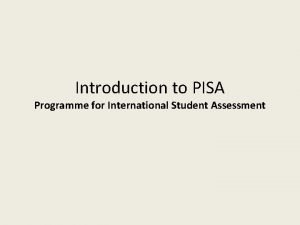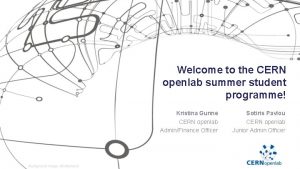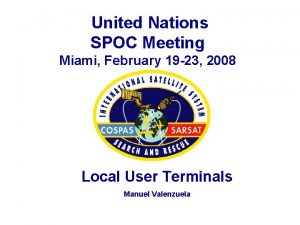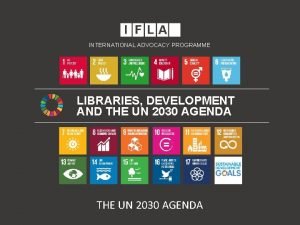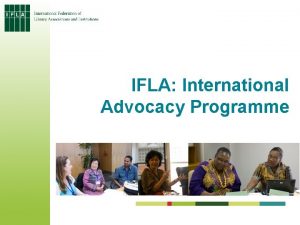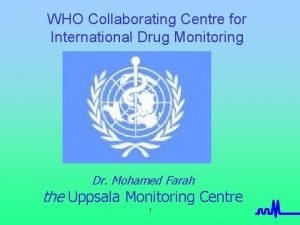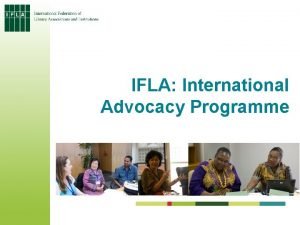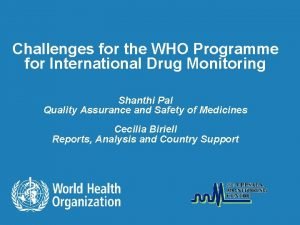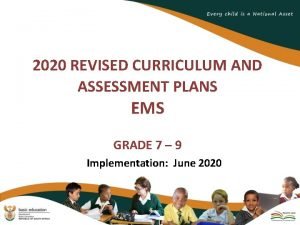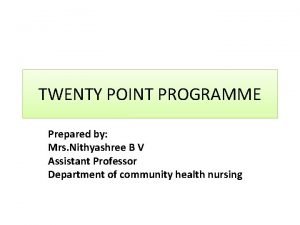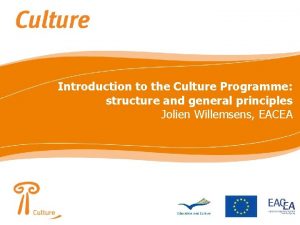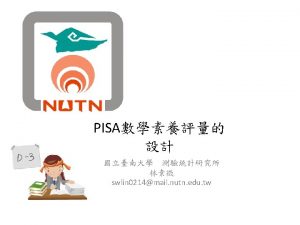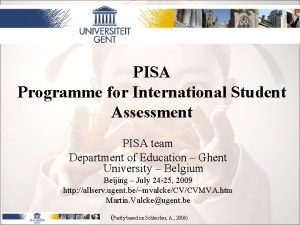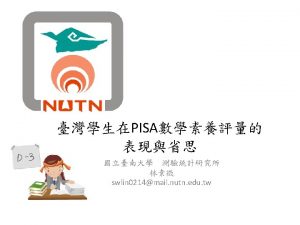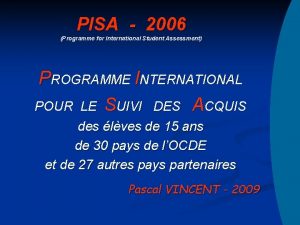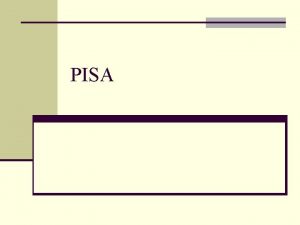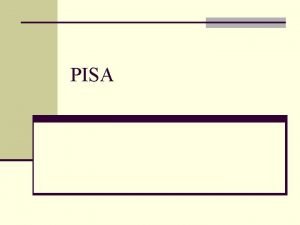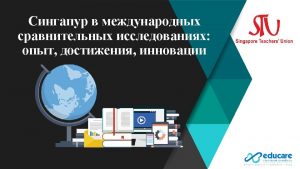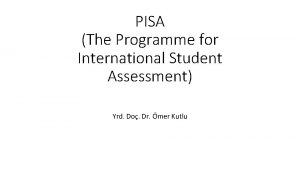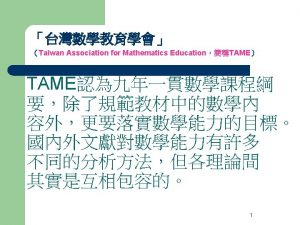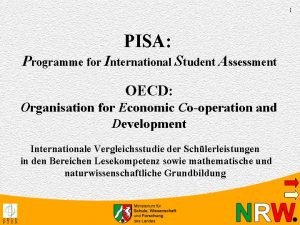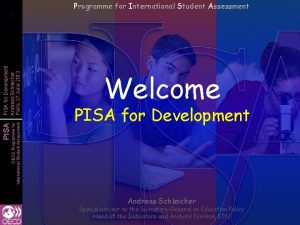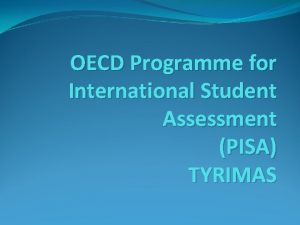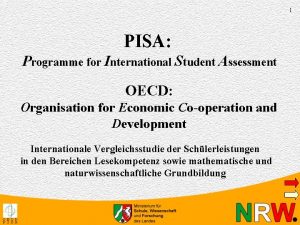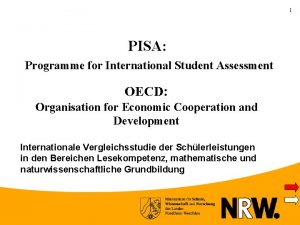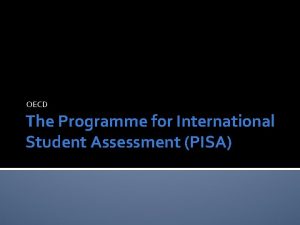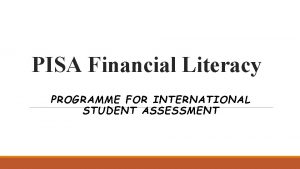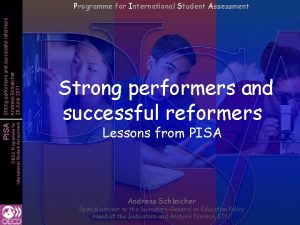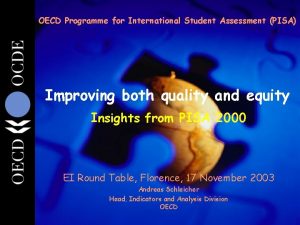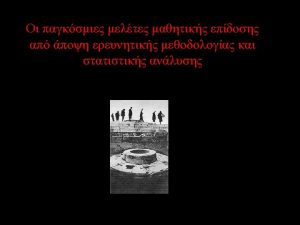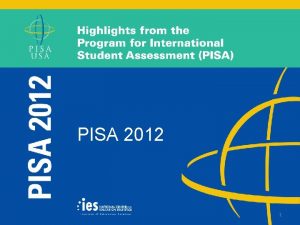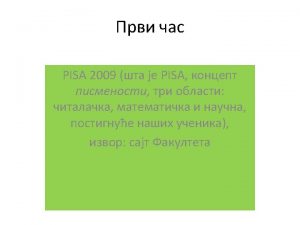Introduction to PISA Programme for International Student Assessment
































- Slides: 32

Introduction to PISA Programme for International Student Assessment

PISA � PISA is the OECD's (Organisation for Economic Co- operation and Development) Programme for International Student Assessment. � Every three years it tests 15 -year-old students from all over the world in reading, mathematics and science. � The tests are designed to gauge how well the students master key subjects in order to be prepared for real-life situations in the adult world. � http: //www. oecd. org/pisa/

India’s Agreement with OECD � PM’s approval was received on 28 th Jan 2019 for signing of Agreement between Ministry of Human Resource Development, Department of School Education & Literacy and OECD for India’s participation in PISA 2021 on 28 th Jan 2019 � Ex Post Facto approval by Cabinet was received on 19 th Feb 2019 � It was decided that schools run by Kendriya Vidyalaya Sangathan (KVS), Navodaya Vidyalaya Samiti (NVS) and schools in the UT of Chandigarh will participate. http: //www. pib. nic. in/Press. Relese. Detail. aspx? PRID=1561704

Why PISA- how will it help India PISA is a competency based assessment which unlike content-based assessment, measures the extent to which students have acquired key competencies that are essential for full participation in modern societies. It would lead to recognition and acceptability of Indian students and prepare them for the global economy in the 21 st century. Learnings from participation in PISA will help to introduce competency based examination reforms in the school system and help move away from rote learning. The CBSE and NCERT will be part of the process and activities leading to the actual test.

Why choose 15 -year-olds? Because in most countries, at the age of 15, students can decide whether or not they want to continue their education. They therefore need to be equipped for adult life. PISA publishes the results of the test a year after the students are tested to help governments shape their education policy.

Age of students Children of age group 15 years 3 months – 16 years 2 months attending any educational institution in the country (selected region), including public, private, aided, international schools. Open Schools students are not eligible. Students born between Jan 2005 to Feb 2006 as test will be held in April 2021

Field Trial(FT) � To be conducted in March-May 2020. � 25 schools and 36 students in each school i. e. 900 students to be assessed through 18 forms to be used for testing 50 students each. � Exact dates to be chosen for field trial

PISA 2021 officially called Main Survey � To be conducted in April 2021 5250 students (150 schools x 35 students) will be assessed on the following subjects: Maths and Science (47% students) Maths and Reading (47% students) Reading and Science (6%students)

Principles of Testing � PISA covers three domains: reading literacy, mathematical literacy and scientific literacy. � PISA aims to define each domain not merely in terms of mastery of the school curriculum, but in terms of important knowledge and skills needed in adult life. � The assessment of cross-curriculum competencies is an integral part of PISA. � Emphasis is placed on the mastery of processes, the understanding of concepts and the ability to function in various situations within each domain. https: //www. acer. org/files/PISA_Thematic_Report_-_Maths_-_web. pdf https: //www. acer. org/files/PISA_Thematic_Report_-_Science_-_web. pdf https: //www. acer. org/files/PISA_Thematic_Report_-_Reading_-_web. pdf

Definitions of the domains Scientific literacy The ability to engage with science-related issues, and with the ideas of science, as a reflective citizen. A scientifically literate person is willing to engage in reasoned discourse about science and technology, which requires the competencies to: • Explain phenomena scientifically – recognise, offer and evaluate explanations for a range of natural and technological phenomena. • Evaluate and design scientific enquiry – describe and appraise scientific investigations and propose ways of addressing questions scientifically. • Interpret data and evidence scientifically – analyse and evaluate data, claims and arguments in a variety of representations and draw appropriate scientific conclusions.

https: //www. acer. org/files/PISA_Thematic_Report_-_Science_-_web. pdf

Definitions of the domains Reading literacy � An individual’s capacity to understand, use, reflect on and engage with written texts, in order to achieve one’s goals, to develop one’s knowledge and potential, and to participate in society.

Definitions of the domains Mathematical literacy � An individual’s capacity to formulate, employ and interpret mathematics in a variety of contexts. � It includes reasoning mathematically and using mathematical concepts, procedures, facts and tools to describe, explain and predict phenomena. � It assists individuals to recognise the role that mathematics plays in the world and to make the wellfounded judgments and decisions needed by constructive, engaged and reflective citizens.

Problems and Issues �Why might learners find PISA difficult? �What skills did you need to answer the questions?

Problems and Issues Too much text/reading. Too much information. Learners don't know how to answer. The questions are long and presented in unfamiliar layouts. Learners don't understand the questions. They give up too easily. They are afraid to be wrong.

Anatomy of PISA style question

Science https: //www. acer. org/files/PISA_Thematic_Report_-_Science_-_web. pdf

SCIENCE QUESTION - OZONE Read the following section of an article about the ozone layer. The atmosphere is an ocean of air and a precious natural resource for sustaining life on the Earth. Unfortunately, human activities based on national/personal interests are causing harm to this common resource, notably by depleting the fragile ozone layer, which acts as a protective shield for life on the Earth. Ozone molecules consist of three oxygen atoms, as opposed to oxygen molecules which consist of two oxygen atoms. Ozone molecules are exceedingly rare: fewer than ten in every million molecules of air. However, for nearly a billion years, their presence in the atmosphere has played a vital role in safeguarding life on Earth. Depending on where it is located, ozone can either protect or harm life on Earth. The ozone in the troposphere (up to 10 kilometres above the Earth’s surface) is “bad” ozone which can damage lung tissues and plants. But about 90 percent of ozone found in the stratosphere (between 10 and 40 kilometres above the Earth’s surface) is “good” ozone which plays a beneficial role by absorbing dangerous ultraviolet (UV-B) radiation from the Sun. Without this beneficial ozone layer, humans would be more susceptible to certain diseases due to the increased incidence of ultra-violet rays from the Sun. In the last decades the amount of ozone has decreased. In 1974 it was hypothesised that chlorofluorocarbons (CFCs) could be a cause for this. Until 1987, scientific assessment of the cause-effect relationship was not convincing enough to implicate CFCs. However, in September 1987, diplomats from around the world met in Montreal (Canada) and agreed to set sharp limits to the use of CFCs. Source: Connect, UNESCO International Science, Technology & Environmental Education Newsletter, section from an article entitled “The Chemistry of Atmospheric policy”, Vol. , XXII No. 2, 19978 (spelling adapted).

Question 1: OZONE S 253 Q 01 - 01 11 12 13 21 22 23 31 99 In the text above nothing is mentioned about the way ozone is formed in the atmosphere. In fact each day some ozone is formed and some other ozone disappears. The way ozone is formed is illustrated in the following comic strip. Suppose you have an uncle who tries to understand the meaning of this strip. However, he did not get any science education at school and he doesn’t understand what the author of the strip is explaining. He knows that there are no little fellows in the atmosphere but he wonders what those little fellows in the strip stand for, what those strange notations O 2 and O 3 mean and which processes the strip represents. He asks you to explain the strip. Assume that your uncle knows: that O is the symbol for oxygen; what atoms and molecules are. Write an explanation of the comic strip for your uncle. In your explanation, use the words atoms and molecules in the way they are used in the para.

Question on OZONE How to score the answer? SCORING: Partially Correct Fully Correct Answers which correctly mention only: Gives an answer in which the following three aspects are mentioned: • First and second aspects only correct. • First and third aspects only correct. • An oxygen molecule or some oxygen molecules • Second and third aspects only correct. (each consisting of two oxygen atoms) are split into • First aspect only correct. oxygen atoms (picture 1). • Second aspect only correct. • The splitting (of oxygen molecules) takes place • Third aspect only correct. under the influence of sunlight (picture 1). Incorrect • The oxygen atoms combine with other oxygen molecules to form ozone molecules (pictures 2 and None of the three aspects correct. 3).

Mathematics https: //www. acer. org/files/PISA_Thematic_Report_-_Maths_-_web. pdf

Mathematics Question- Making a booklet Question 1: MAKING A BOOKLET M 598 Q 01 - 019 Question intent: Space and shape Figure 1 shows how to make a small booklet. The instructions are given below: Take a piece of paper and fold it twice. Staple edge a. Cut open two edges at b. The result is a small booklet with eight pages. Figure 2 shows one side of a piece of paper that is used to make such a booklet. The page numbers have been put on the paper in advance. The thick line indicates where the paper will be cut after folding.

Write the numbers 1, 4, 5 and 8 in the correct boxes in the following diagram to show which page number is directly behind each of the page numbers 2, 3, 6 and 7.

Mathematics Scoring Correct Page numbers placed correctly in the following positions 1 8 (ignore the orientation of the numbers) 5 4

Reading https: //www. acer. org/files/PISA_Thematic_Report_-_Reading_-_web. pdf

PLAN INTERNATIONAL

The preceding table is part of a report published by PLAN International, an international aid organization. It gives some information about PLAN’s work in one of its regions of operation (Eastern and Southern Africa). Refer to the table to answer the following questions. Question 1: PLAN INTERNATIONAL R 099 Q 04 A What does the table indicate about the level of PLAN International’s activity in Ethiopia in 1996, compared with other countries in the region? • • The level of activity was comparatively high in Ethiopia. The level of activity was comparatively low in Ethiopia. It was about the same as in other countries in the region. It was comparatively high in the Habitat category, and low in the other categories.

Scoring pattern is unique SCORING: Correct Answer B. The level of activity was comparatively low in Ethiopia. Incorrect Other responses. Note: This question is for information only and will not independently contribute to the student’s score. The answer is taken into account in assessing the response to Question 2.

Scoring pattern is unique Question 2: PLAN INTERNATIONAL R 099 Q 04 B-01239 In 1996 Ethiopia was one of the poorest countries in the world. Taking this fact and the information in the table into account, what do you think might explain the level of PLAN International’s activities in Ethiopia compared with its activities in other countries? SCORING: Fully Correct Student has answered Question 1 correctly (Answer B). Answers which explain the level of PLAN’s activity by drawing on ALL the information supplied, with explicit or implicit reference to the type of activity conducted in Ethiopia by PLAN. Answer must also be consistent with (though does not need to refer to) BOTH of the following: PLAN’s low level of activity in Ethiopia (information supplied in the table); AND Ethiopia’s poverty (information given in the stem). Partially Correct Student has answered Question 1 correctly (Answer B). Answers which explain the level of PLAN’s work by drawing on MOST of the information supplied. Answer must be consistent with (though does not need to refer to) BOTH of the following: PLAN’s low level of activity in Ethiopia (information supplied in the table); AND Ethiopia’s poverty (information given in the stem).

Scoring pattern is unique- even if Answer to Part 1 is correct no marks are given Incorrect- THIS IS IMPORTANT Student has answered Question 1 incorrectly (not Answer B). OR Student has answered Question 1 correctly (Answer B) but the answer does not take into account the information supplied about Ethiopia’s relative poverty, or is insufficient, vague, implausible, or irrelevant.

Thus PISA test is different Focus is on understanding Proper reading No guesswork Answers are related to previous answers

Resources https: //learning. gov. wales/resources/learningpacks/pisa/module 8/? lang=en#/resources/learningpacks/pisa/module-8/training-pack/? lang=en https: //learning. gov. wales/docs/learningwales/publications/120629 pisabookleten. pdf https: //learning. gov. wales/docs/learningwales/publications/130429 how-to-develop-thinking-en. pdf https: //learning. gov. wales/resources/learningpacks/pisa/Deconstructing-pisa-style-and-samplequestions/? lang=en#/resources/learningpacks/pisa/Deconstructing-pisa-style-and-samplequestions/training-pack/? lang=en http: //www. bcsea. bt/index. php/pisa-released-items/ http: //www. oecd. org/pisa/test/ http: //www. oecd. org/pisa/ http: //www. oecd. org/publications/ten-questions-for-mathematics-teachers-and-how-pisa-can-helpanswer-them-9789264265387 -en. htm https: //www. acer. org/files/PISA_Thematic_Report_-_Maths_-_web. pdf https: //www. acer. org/files/PISA_Thematic_Report_-_Science_-_web. pdf https: //www. acer. org/files/PISA_Thematic_Report_-_Reading_-_web. pdf http: //www. gov. pe. ca/photos/original/ed_PISA_read 1. pdf
 What does pisa stand for
What does pisa stand for Cern openlab summer student programme
Cern openlab summer student programme Meolut
Meolut Twitterifla
Twitterifla International advocacy programme
International advocacy programme Pull out you've hit an artery
Pull out you've hit an artery International advocacy programme
International advocacy programme Who programme for international drug monitoring
Who programme for international drug monitoring Creative arts grade 7 term 1 assessment
Creative arts grade 7 term 1 assessment Ems grade 8 term 3 case study
Ems grade 8 term 3 case study Revised programme of assessment 2020
Revised programme of assessment 2020 2020 revised curriculum and assessment plans grade 7
2020 revised curriculum and assessment plans grade 7 Revised programme of assessment 2020
Revised programme of assessment 2020 20 point programme was introduced by
20 point programme was introduced by Introduction for cultural programme
Introduction for cultural programme Fspos vägledning för kontinuitetshantering
Fspos vägledning för kontinuitetshantering Typiska novell drag
Typiska novell drag Tack för att ni lyssnade bild
Tack för att ni lyssnade bild Returpilarna
Returpilarna Varför kallas perioden 1918-1939 för mellankrigstiden
Varför kallas perioden 1918-1939 för mellankrigstiden En lathund för arbete med kontinuitetshantering
En lathund för arbete med kontinuitetshantering Adressändring ideell förening
Adressändring ideell förening Tidbok
Tidbok A gastrica
A gastrica Densitet vatten
Densitet vatten Datorkunskap för nybörjare
Datorkunskap för nybörjare Tack för att ni lyssnade bild
Tack för att ni lyssnade bild Mall debattartikel
Mall debattartikel Delegerande ledarskap
Delegerande ledarskap Nyckelkompetenser för livslångt lärande
Nyckelkompetenser för livslångt lärande Påbyggnader för flakfordon
Påbyggnader för flakfordon Arkimedes princip formel
Arkimedes princip formel Svenskt ramverk för digital samverkan
Svenskt ramverk för digital samverkan
